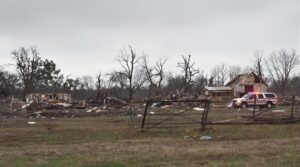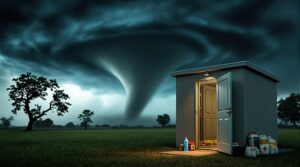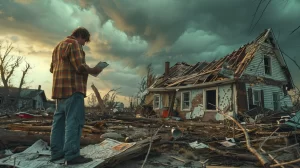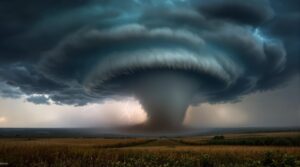Storm shelters require thorough preparation for maximum safety during tornadoes. Two primary shelter types exist: above-ground and underground installations, each with distinct advantages. Essential preparations include stocking non-perishable foods stored at 40°-70°F, maintaining survival kits with 3-14 days of supplies, and establishing clear family safety protocols. Regular maintenance through biannual inspections guarantees shelter readiness. Understanding proper insurance coverage and claims processes provides vital protection beyond the immediate emergency.
Key Takeaways
- Choose between above-ground shelters for accessibility or underground shelters for maximum protection, depending on your space and budget requirements.
- Stock non-perishable food and water for 3-14 days, storing items in airtight containers at 40°-70°F with proper labeling.
- Create a comprehensive survival kit including medical supplies, communication tools, emergency blankets, and critical documentation.
- Establish and practice a family emergency plan with designated safe zones, evacuation routes, and clear communication strategies.
- Maintain your shelter through biannual inspections, regular supply rotation, and proper ventilation system cleaning to ensure year-round readiness.
Types of Storm Shelters for Maximum Protection
When it comes to protecting lives during severe weather events, storm shelters fall into two main categories: above-ground and underground installations.
Each type offers distinct advantages for different situations and needs.
Above Ground Benefits include easier accessibility and simpler installation processes, making them ideal for residential properties. These shelters can be integrated into existing structures like garages and patios, accommodating 4-6 occupants.
Models such as the TwisterPod series demonstrate the capability to withstand EF5 tornadoes through reinforced steel construction and secure ground anchoring.
Underground Safety represents the highest level of storm protection, with shelters like the GarageCube and Estate models housing up to 16 people.
These installations utilize reinforced steel and concrete construction, preventing uplift during severe weather conditions.
While installation requires more extensive excavation and higher costs, underground shelters provide superior protection by minimizing exposure to dangerous wind forces and flying debris.
Essential Emergency Food Supplies and Storage
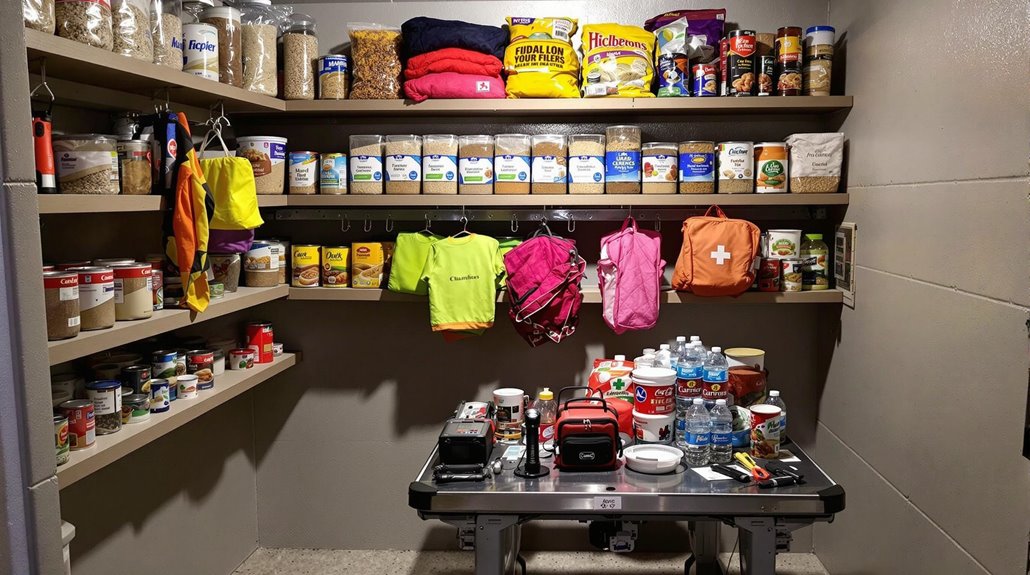
Having a well-protected shelter is only part of tornado preparedness – stocking it with appropriate emergency food supplies guarantees survival during extended periods of confinement.
Effective emergency nutrition planning requires storing non-perishable items like canned goods, high-energy foods, and hydration supplies in cool, dry locations between 40° and 70°F.
Long term food storage necessitates proper containment systems using Mylar bags with oxygen absorbers, airtight containers, and waterproof bins.
All items should be labeled with contents and expiration dates, implementing a rotating system to prevent spoilage.
Essential supplies include canned meats, fruits, and vegetables; nutrient-rich foods like nuts and trail mix; and beverages including water and electrolyte drinks.
Special consideration must be given to dietary restrictions, infant needs, and pet supplies.
Storage areas should include necessary tools such as manual can openers, portable cooking equipment, and sanitation supplies to maintain food safety during emergencies.
Building Your Comprehensive Survival Kit
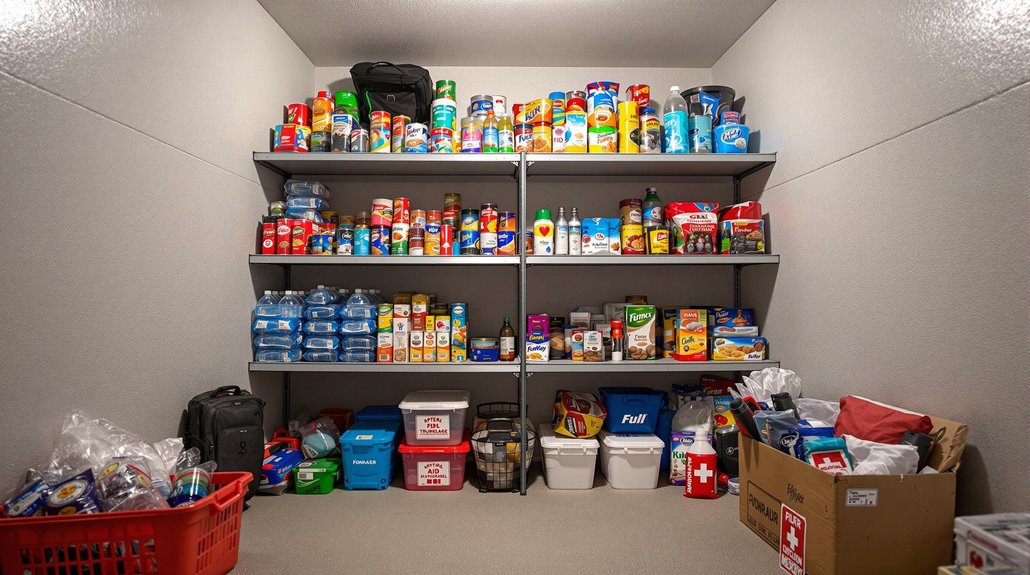
A thorough survival kit forms the foundation of effective tornado preparedness, incorporating five essential categories of emergency supplies.
These survival kit essentials include sustenance (non-perishable food and water for 3-14 days), medical supplies (first aid materials and seven days of medications), communication tools (weather radio and cell phone), basic equipment (multi-tool and emergency blanket), and critical documentation (identification and insurance papers).
The kit should feature customizable options based on specific household needs. Families with infants require formula and diapers, while pet owners must include animal supplies and identification tags.
Additional considerations include emergency lighting, shelter materials, and security items. Regular maintenance guarantees all components remain functional and unexpired, while proper storage keeps supplies readily accessible during tornado threats.
Creating a thorough communication plan and establishing meeting points complement the physical preparation, guaranteeing all family members understand emergency procedures and kit locations.
Creating and Practicing Your Family Safety Plan
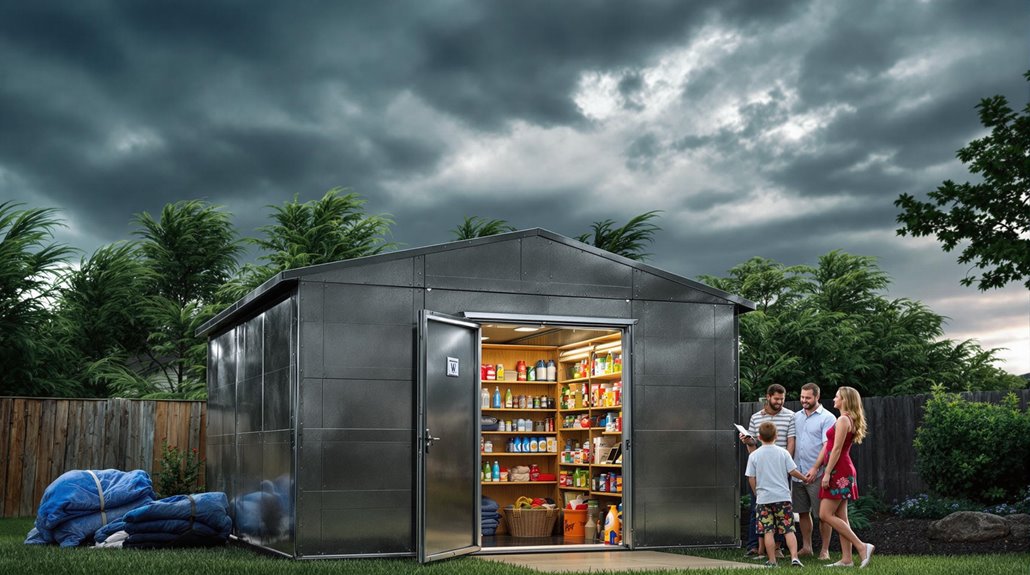
Beyond assembling survival supplies, effective tornado preparedness requires a well-structured family safety plan that encompasses designated safe zones, evacuation routes, and emergency procedures. Regular family meetings guarantee all household members understand their roles and responsibilities during an emergency. The plan should establish clear communication strategies and identify multiple shelter options.
| Safety Plan Elements | Home Actions | Away Actions |
|---|---|---|
| Primary Shelter | Basement/Interior Room | Public Building |
| Communication | Meeting Point | Phone Protocol |
| Special Needs | Children/Pets | Work/School |
Practicing the emergency plan through periodic drills helps familiarize everyone with evacuation routes and safe zones. Children should learn to recognize warning signs and understand local alert systems. The plan must account for scenarios when family members are separated at school, work, or other locations. Regular plan reviews and updates guarantee continued effectiveness, particularly when household circumstances change or new safety information becomes available.
Maintaining Your Storm Shelter Year-Round
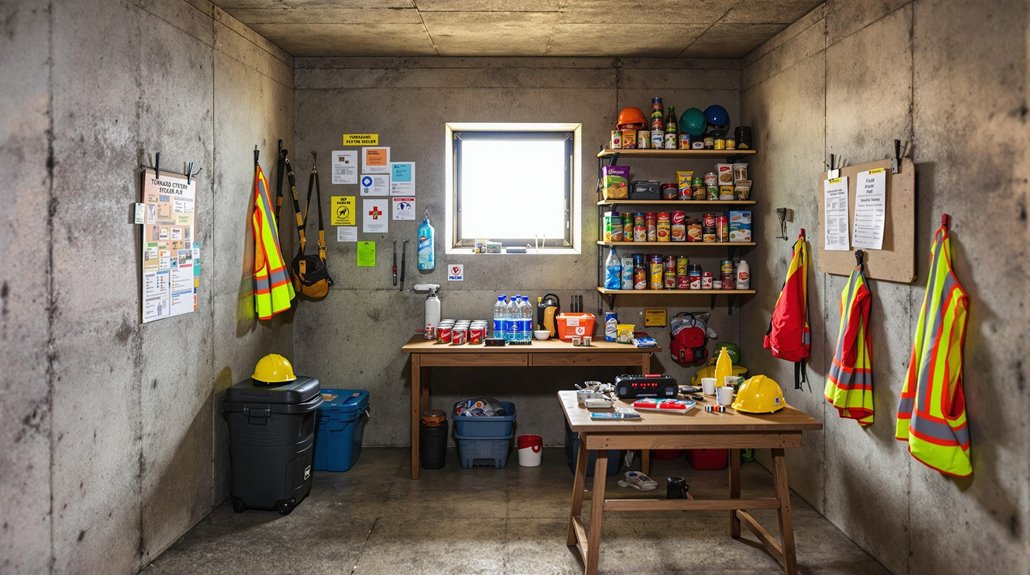
Maintaining a storm shelter throughout the year requires systematic attention to confirm its reliability during severe weather events. Regular inspections should occur biannually, with additional checks following significant weather events. A thorough maintenance checklist should address structural integrity, ventilation systems, and waterproofing components.
Essential maintenance tasks create a secure environment:
- Scrubbing walls and floors with disinfectant while checking for cracks or water damage
- Testing safety equipment including flashlights, weather radios, and ventilation systems
- Organizing and rotating emergency supplies based on expiration dates
Proper shelter maintenance extends beyond cleaning to include systematic inventory management of essential supplies and regular pest control measures.
Ventilation systems require particular attention, with regular filter replacements and vent cleaning to confirm adequate airflow. Implementing moisture control through dehumidifiers helps prevent mold growth, while quarterly cleaning prevents debris accumulation and pest infestations.
Special Considerations for Children and Pets

Ensuring the safety of children and pets during severe weather events requires specialized preparation and dedicated shelter accommodations.
Pet owners should stock their shelters with essential supplies including food, water, bedding, and comfort items to minimize pet anxiety during emergencies. A familiar blanket or toy can provide vital emotional support for animals during stressful situations.
Proper evacuation planning involves familiarizing pets with shelter spaces through regular practice sessions. Using kennels or crates within the shelter helps maintain control and prevents panic-induced behaviors.
The shelter environment should be free from hazardous materials that could endanger both children and pets during confinement.
Post-event preparation is equally important, requiring additional supplies for extended shelter stays. Emergency kits should contain pet identification, recent photos, extra leashes, and necessary medications.
Regular shelter practice sessions help establish routines that can reduce stress and confusion when severe weather threatens.
The Benefits Of Consulting A Public Adjuster
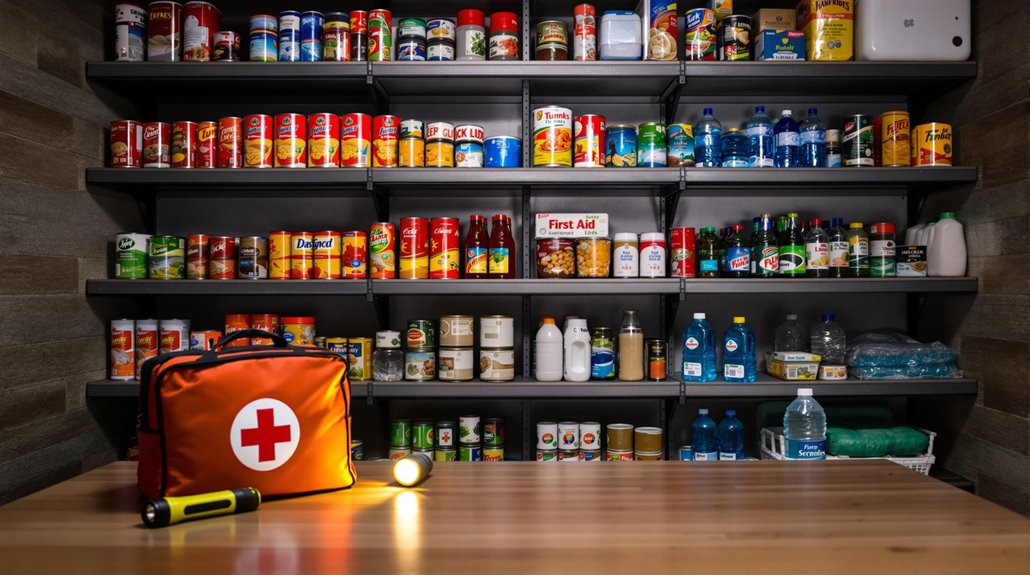
When facing tornado damage to a storm shelter or property, consulting a public adjuster provides critical expertise in maneuvering complex insurance claims and securing fair settlements.
These licensed professionals conduct thorough, objective assessments of storm damage while managing all documentation and negotiations with insurance companies.
Public adjusters typically help property owners secure higher claim payouts through their detailed understanding of policies, extensive damage documentation, and skilled negotiation strategies.
Studies show that insurance claim settlements can increase by up to 500% for non-catastrophe claims when working with a qualified public adjuster.
Expertise In Insurance Claims
Dealing with tornado damage claims can overwhelm even the most organized property owners, which is why consulting a public adjuster often proves invaluable. These professionals possess specialized knowledge in insurance claim strategies and claims negotiation tactics, ensuring extensive documentation of all damages, including those not immediately visible.
Public adjusters provide expert guidance through the complex claims process by:
- Conducting detailed property inspections to identify structural damage, foundation issues, and hidden water damage.
- Preparing thorough documentation with photos, videos, and expert assessments to support maximum claim value.
- Implementing proven negotiation techniques with insurance companies to secure fair settlements.
Working on a contingency basis, public adjusters are motivated to maximize claim settlements while removing the emotional burden from property owners during the recovery process. Unlike insurance company adjusters who focus on minimizing settlement costs, public adjusters serve as dedicated advocates ensuring policyholders receive the maximum compensation they deserve.
Objective Damage Assessment
Professional assessment of tornado damage requires an objective evaluation by a qualified public adjuster to ascertain accurate documentation and fair compensation. Public adjusters conduct thorough inspections to identify both visible wind damage and concealed structural integrity issues that may compromise the building's safety.
| Assessment Area | Key Benefits |
|---|---|
| Documentation | Detailed photography and reports |
| Hidden Damage | Detection of concealed vulnerabilities |
| Cost Analysis | Accurate repair estimations |
| Insurance Claims | Expert policy interpretation |
Their extensive evaluation includes systematic documentation of all damages, professional cost estimations, and detailed reporting that strengthens insurance claims. Public adjusters translate complex insurance terminology into clear terms, enabling property owners to understand their coverage fully while focusing on recovery efforts. Their expertise ascertains that no damage goes unnoticed and that claims reflect the full extent of necessary repairs. While typical adjusters represent insurance companies, independent claims adjusters work directly for policyholders to advocate for maximum settlement value.
Streamlined Claim Process
Engaging a public adjuster transforms the complex tornado damage claim process into a streamlined, efficient experience for property owners.
These professionals manage every aspect of claim submission and tracking while providing expert advocacy throughout the settlement process. Their thorough oversight guarantees faster resolution through proper documentation, efficient communication, and skilled negotiations with insurance companies.
- Systematically documents tornado damage through detailed photographs, measurements, and professional assessments
- Meticulously prepares and organizes all required paperwork for maximum claim accuracy
- Continuously monitors claim progress through established channels, addressing potential issues before they cause delays
Public adjusters shoulder the burden of claim management, allowing property owners to focus on recovery.
Their expertise in policy interpretation and insurance laws helps secure fair settlements while minimizing stress and avoiding common pitfalls in the claims process.
Working on a contingency fee basis, they typically charge 5-20% of the final settlement amount for their valuable services.
Higher Claim Payouts & Settlements
The financial benefits of hiring a public adjuster for tornado damage claims are well-documented through empirical data and case studies. Research indicates that policyholders who engage public adjusters receive notably higher settlements, with average payouts increasing by up to 40% in some regions.
Public adjusters employ effective claim negotiation strategies, including thorough damage assessments and meticulous documentation of all losses.
Working on a contingency basis of typically 10% of the settlement, these licensed professionals utilize their specialized knowledge to identify hidden damages that property owners might overlook. Their expertise in maximizing settlements often results in higher payouts that offset their fees, as demonstrated by data from the Florida Association of Public Insurance Adjusters showing an average difference of $3,607 in favor of claims handled by public adjusters. Through the Public Claims Adjusters Network, policyholders can connect with pre-vetted professionals who maintain strict ethical standards and undergo regular performance audits.
About The Public Claims Adjusters Network (PCAN)
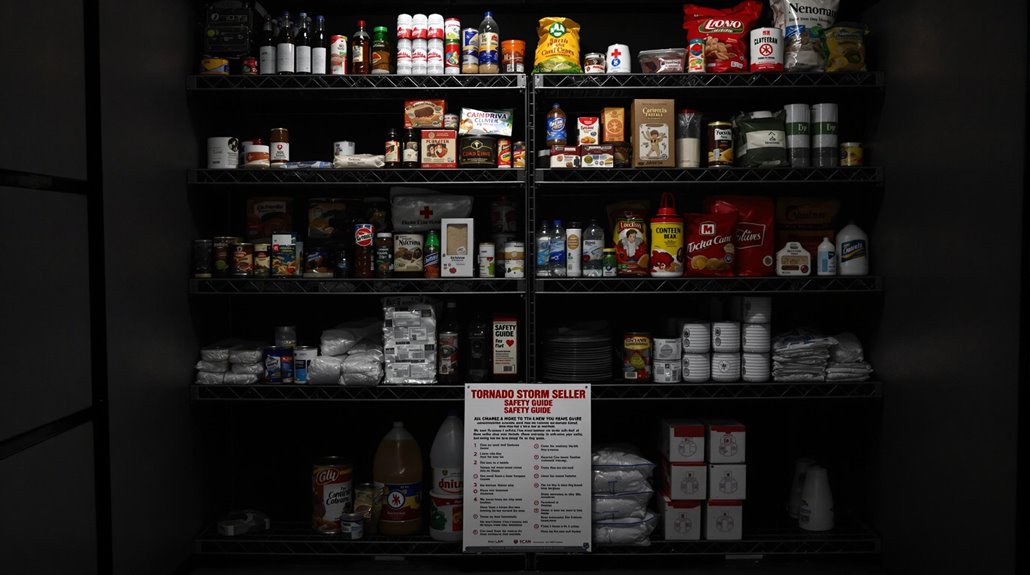
Dedicated to policyholder advocacy, Public Claims Adjusters Network (PCAN) represents a coalition of licensed insurance claims professionals who work independently to maximize settlements for property owners.
Through thorough public adjuster certifications and advanced claims negotiation tactics, PCAN members provide expert guidance throughout the entire claims process.
The network maintains stringent professional standards while offering customized solutions for complex insurance matters. Their services include detailed damage assessments, policy interpretation, and strategic negotiations with insurance carriers.
Key benefits of working with PCAN members include:
- Access to a nationwide network of experienced adjusters who handle emergency response within hours of property damage
- Thorough documentation services utilizing advanced technology for accurate damage assessment
- Strategic negotiation support backed by decades of industry experience and proven methodologies
PCAN members operate on a contingency basis, ensuring their interests align with policyholders while maintaining the highest standards of professional integrity and service delivery.
Frequently Asked Questions
How Much Does a Typical Tornado Shelter Installation Cost?
The installation process for tornado shelters typically costs between $3,500 and $15,000, with average expenses around $7,643. Shelter financing options help manage these costs based on material and location variables.
Can People With Claustrophobia Safely Use Underground Tornado Shelters?
People with claustrophobia can use underground shelters safely through proper shelter design incorporating larger spaces and ventilation, combined with claustrophobia coping techniques like breathing exercises and professional psychological preparation.
What's the Average Lifespan of a Professionally Installed Storm Shelter?
Like the pyramids of Giza, professionally installed storm shelters can endure generations. With proper shelter maintenance and attention to lifespan factors, these structures typically last 100-150 years when built using steel or fiberglass.
Are There Government Grants or Tax Incentives for Installing Tornado Shelters?
FEMA provides government funding covering up to 75% of shelter costs through various programs. States administer tax rebates and grants, while FHA mortgage programs offer additional financing options.
How Many People Can Typically Fit in a Standard Residential Shelter?
Standard residential shelter capacity accommodates up to 16 occupants per emergency preparedness guidelines, requiring 3 square feet per person in single-family homes and 5 square feet in other residential settings.
References
- https://en.wikipedia.org/wiki/Storm_cellar
- https://www.fcs.uga.edu/extension/preparing-an-emergency-food-supply-short-term-food-storage
- https://www.cdc.gov/tornadoes/safety/index.html
- https://survive-a-storm.com/blog/exploring-the-types-of-residential-tornado-shelters/
- https://rainbowrestores.com/blog/here-s-your-tornado-shelter-supplies-checklist
- https://survive-a-storm.com/residential-storm-shelters/
- https://www.safe-rooms.us/the-science-behind-ef5-rated-storm-shelters-ensuring-maximum-protection/
- https://atlassaferooms.com/a-guide-to-the-different-home-storm-shelter-types/
- https://survive-a-storm.com/residential-storm-shelters/twisterpod/
- https://www.groundzeroshelters.com/blog/foods-to-stockpile-in-case-of-emergency

